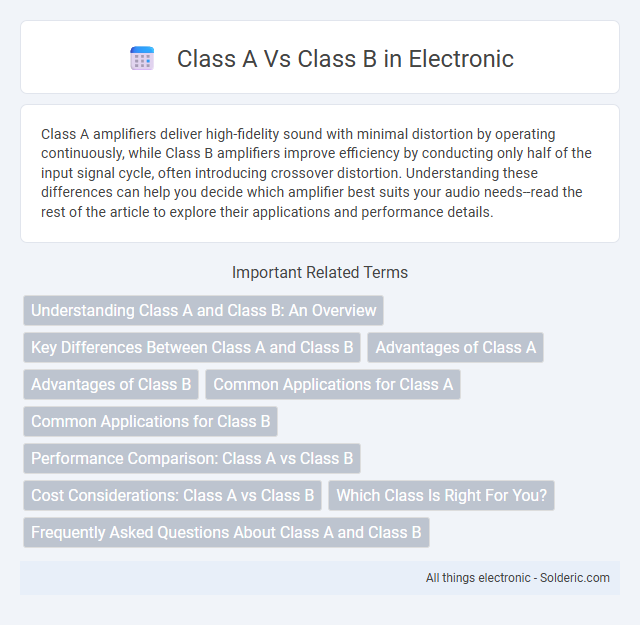Class A amplifiers deliver high-fidelity sound with minimal distortion by operating continuously, while Class B amplifiers improve efficiency by conducting only half of the input signal cycle, often introducing crossover distortion. Understanding these differences can help you decide which amplifier best suits your audio needs--read the rest of the article to explore their applications and performance details.
Comparison Table
| Feature | Class A | Class B |
|---|---|---|
| Power Efficiency | Lower efficiency; higher power consumption | Higher efficiency; lower power consumption |
| Output Signal Quality | High linearity and low distortion | Moderate linearity; potential crossover distortion |
| Heat Generation | Significant heat produced | Less heat generated |
| Complexity | Simple circuit design | More complex due to push-pull configuration |
| Applications | High-fidelity audio and RF amplifiers | Audio amplifiers and efficient power amplifiers |
Understanding Class A and Class B: An Overview
Class A and Class B refer to different categories of stock shares or amplifier designs, each with unique characteristics and applications. Class A stock typically grants shareholders full voting rights and priority in dividends, offering greater control and income potential, while Class B stock often comes with limited voting power but may provide different economic benefits. You can determine the best choice by assessing your need for control, income preferences, and investment goals in the context of these classifications.
Key Differences Between Class A and Class B
Class A and Class B amplifiers differ primarily in their conduction angle, with Class A amplifiers conducting current throughout the entire input signal cycle, resulting in higher fidelity and lower distortion but reduced efficiency. Class B amplifiers conduct current only during half of the signal cycle, improving efficiency but potentially introducing crossover distortion. Your choice between Class A and Class B depends on the balance you need between audio quality and power efficiency in your application.
Advantages of Class A
Class A amplifiers offer superior linearity and low distortion, making them ideal for high-fidelity audio applications. They operate with a consistent current flow, which ensures minimal signal crossover distortion and excellent sound quality. Despite lower power efficiency compared to Class B, Class A amplifiers provide unmatched audio clarity and warmth favored by audiophiles.
Advantages of Class B
Class B amplifiers offer higher efficiency than Class A, making them ideal for applications where power conservation and heat dissipation are critical. Their design allows for less distortion in audio signals during medium to high power output, enhancing sound clarity and overall performance. You can benefit from lower energy consumption and reduced thermal management requirements, making Class B amplifiers practical for portable and battery-powered devices.
Common Applications for Class A
Class A amplifiers are commonly used in high-fidelity audio equipment, where their low distortion and superior linearity deliver exceptionally clear sound quality. They are also favored in RF transmitters for their ability to provide consistent, high-quality signal amplification ideal for communication devices. If you require precise audio or signal reproduction, Class A amplifiers ensure your performance demands are met with minimal signal degradation.
Common Applications for Class B
Class B amplifiers are commonly used in applications requiring high efficiency and moderate linearity, such as FM radio transmitters, audio amplification in portable devices, and public address systems. These amplifiers operate by conducting each transistor for exactly half of the input signal cycle, reducing power loss and improving thermal performance. Your choice of a Class B amplifier suits scenarios where power efficiency is prioritized over minimal distortion.
Performance Comparison: Class A vs Class B
Class A amplifiers deliver higher fidelity and lower distortion due to their continuous conduction of current, resulting in superior audio performance especially in high-end audio applications. Class B amplifiers exhibit greater efficiency by operating in a push-pull configuration that reduces power loss, making them ideal for applications requiring higher power output with moderate fidelity. The trade-off between Class A and Class B amplifiers lies in the balance of sound quality versus energy efficiency, where Class A prioritizes audio purity and Class B emphasizes reduced heat dissipation and power consumption.
Cost Considerations: Class A vs Class B
Class A RVs typically have higher upfront costs, ranging from $60,000 to over $300,000, due to their luxury features and larger size, while Class B camper vans usually cost between $50,000 and $150,000, offering a more budget-friendly and compact option. Maintenance and fuel expenses for Class A vehicles can be significantly higher because of their weight and engine size, whereas Class B RVs provide better fuel efficiency and lower upkeep costs, making them more economical over time. Your choice between Class A and Class B should carefully weigh these cost differences against your travel needs and lifestyle preferences for optimal value.
Which Class Is Right For You?
Choosing between Class A and Class B motorhomes depends on your travel needs and lifestyle preferences. Class A models offer spacious interiors and luxury features ideal for extended trips and larger groups, while Class B vans provide better maneuverability and fuel efficiency, perfect for solo travelers or couples seeking convenience. Your decision should consider factors like budget, driving comfort, and the type of adventures you plan to embark on.
Frequently Asked Questions About Class A and Class B
Class A and Class B distinctions often arise in contexts like amplifiers, motor vehicles, and office classifications, leading to common questions about their differences and applications. Class A amplifiers are known for high fidelity and continuous conduction, while Class B amplifiers operate with higher efficiency but introduce crossover distortion. Understanding which class suits your needs involves considering factors like performance requirements, efficiency, and specific industry standards.
Class A vs Class B Infographic

 solderic.com
solderic.com